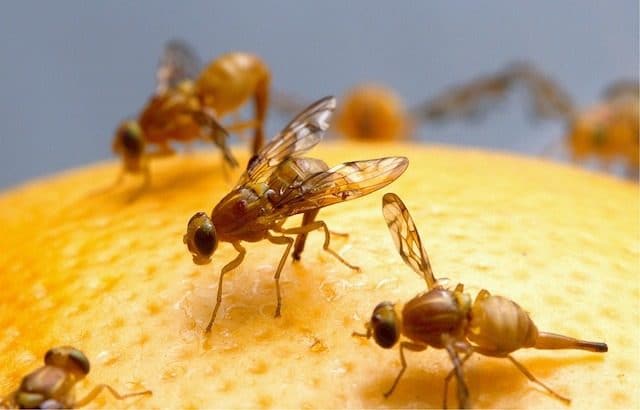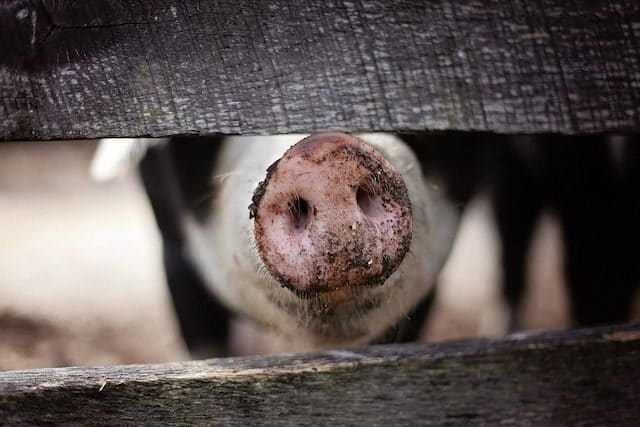Humans aren’t the only species to suffer from mental maladies. Although schizophrenia appears to be unique to mankind (perhaps as a social construction), non-human animals exhibit plenty of other psychiatric conditions.
And why shouldn’t they? They all suffer to some extent from the consequences of human activity, and many face genocide daily. But what you might find surprising is the sheer variety of disorders that affect them, as well as the consistency of symptoms, manifesting in similar ways even between animals of different species.
As mental health advocates are keen to point out: “You are not alone.” And, as this list goes to show, that applies to your species too.
10. Depression
It’s hardly surprising that animals can suffer from depression—or that humans are generally to blame. Causes include unsolvable problems (e.g. non-specific scolding leaving pets confused about what they’ve done wrong, if anything), an inability to escape abuse (i.e. learned helplessness), and insufficient access to food or opportunities for natural behavior (e.g. hunting, mating, socializing). Caged hens get depressed, for instance, when they’re unable to get out and forage.
There are telltale signs in most species, but some are more obvious than others. Arturo, “the world’s saddest polar bear,” died in captivity in 2016, having spent his final years pacing up and down. He was also seen rocking from side to side and displaying his teeth as a sign of discomfort. Although his symptoms were blamed on old age (by the zoo), his living conditions can’t have helped much, what with Argentinian summer temperatures frequently exceeding 86° F. His despondency may also have had something to do with the death of his longtime companion, Pelusa, in 2012. Toward the end of his life, Arturo completely lost interest in eating and began to shed some of his weight.
Not only are the symptoms of depression shared between animals and humans, but the treatments can be similar too. Pet antidepressants are apparently more common than ever, and they’re reportedly effective as well. As with humans, though, it’s better to limit their use, perhaps combining a short course of meds with targeted behavioral therapy. Of course, improving living conditions, accommodating natural behaviors, and giving adequate care and attention should prevent the onset of depression in the first place.
9. Anxiety

Anxiety disorders in humans hijack the fight-or-flight instinct, a survival mechanism evolved to rapidly respond to threats. So, like depression, it isn’t that surprising to find animals suffering from them too. To be clear, we’re not talking about the fear responses of animals filing through slaughterhouses—or cowering from fireworks or thunderstorms—all of which are relatively sane and understandable. We’re talking about chronic disorders, or anxiety that persists in the absence of rational cues.
Cats and dogs are often diagnosed with generalized anxiety disorder (GAD), which may present itself in panting, pacing, trembling, holding the ears back, holding the mouth in a submissive grin, hiding, or simply staying still. The condition can be treated with SSRI (selective serotonin reuptake inhibitor) medications like fluoxetine (Prozac) or anti-anxiety medications like diazepam (Valium)—or, better yet, with behavioral conditioning and care.
Horses are also prone to anxiety, which may cause them to bolt off or grind their teeth. As in humans, causes are varied. They may include confusion (i.e. not knowing where they are, why, or what they have to do), vision problems (which may cause confusion), pain, discomfort (e.g. an ill-fitting saddle), poor diet, insufficient exercise, past trauma, and even the anxiety of their handler. Genetics may also play a part, as some breeds (e.g. Thoroughbred, Arabian) are apparently more prone (“hotter”) than others. Weaning too early is another recognized cause, but horses get separation anxiety in general. They hate to be away from their herd (or the few companions that pass for one) and will often pick up “vices” in seclusion, such as chewing on wood, kicking down doors, fidgeting, pacing, and a behavior known as ‘cribbing’ whereby lonely horses set their teeth into a fixed object, arch their neck, and pull backwards, sucking in air to cause an addictive release of endorphins. Separation anxiety in horses also leads to (and is aggravated by) poor quality sleep. Without the security of their companions, it seems, they’re unable to fully relax, becoming exhausted, agitated, and more prone to full-blown panic.
Unfortunately it’s often the “hotter” horses that get isolated or mistreated as a result, which only makes their anxiety worse. It’s better to learn how to understand and appropriately respond to horses’ needs—or to become a bit of a horse whisperer, in other words, and buck the trend of equine abuse.
8. Addiction

Addiction in animals is such a reliable psychological (or neurological) condition that it allows us to model addiction in humans. Animal studies have, for example, shown that the action of a drug is often sufficient to produce addiction on its own—without any need for an underlying pathology. In simple terms, dopamine (a chemical normally released during sex or feeding, behaviors that promote our survival) functions as a powerful reward mechanism, causing the brain to crave more of whatever gave rise to its release—be it food, sex, or drugs. In other words, addiction can happen just as reliably with candy as it can with crack cocaine—and just as reliably in humans as it can in non-human animals.
But it’s far more shocking to see animals addicted to drugs that are more or less normalized among humans. Hence footage of an orangutan smoking a cigarette caused outrage earlier this year and drew criticism of Indonesian zoos. The cigarette had been flicked into the great ape’s enclosure by a visitor, perhaps at the animal’s own request. Some have been smoking for years, mimicking human behavior by holding cigarettes between their index and middle fingers. And whenever they want a smoke, all they have to do is make this gesture to the crowd and a visitor will toss a lit cigarette their way—if only for the entertainment value. If they don’t get one, they may become angry and start throwing things and they won’t even be distracted with food.
The solution, besides relocating animals away from the toxic influence of humans, appears to be going cold turkey.
7. ADHD

Many of us have experienced hyperactivity in dogs and it’s usually the result of their breed or training. Only rarely can it be diagnosed as ADHD (attention deficit hyperactivity disorder), but it does happen.
There’s actually no reason why animals shouldn’t get ADHD. Even fruit flies’ brains are similar enough to our own to develop the condition. Although they only have 250,000 neurons or so (compared to our 86 billion), they’re evidently capable of “emotion-like” behaviors based on dopamine and serotonin activity—neurotransmission involved in mood, memory, and most psychiatric disorders. Fruit flies have long been studied for insights into human learning, but they could also help us model more complex disorders like ADHD.
In one experiment, fruit flies in a test chamber were subjected to a rapid succession of “brief but brisk air puffs,” causing them to run around in a “frantic manner” for several minutes even after the air puffs had stopped. Once they calmed down, all it took was a single air puff for them to repeat the frantic behavior. While this might seem perfectly normal for flies, their hyperactivity was actually attributed to a genetic mutation that eliminated dopamine receptors from neurons. In other words, their behavior was caused by an absence of dopamine activity. Non-mutant flies were more relaxed.
And this supports what we know about the condition in humans, who often take dopamine reuptake inhibitors (drugs to increase dopamine levels in the brain) such as Ritalin. Also, just like human ADHD patients, mutant fruit flies given cocaine were actually less hyperactive as a result. Earlier studies also showed they had difficulties learning new information; the mutation prevented them from associating particular odors with negative outcomes (electric shocks). This suggests that it’s not the hyperactivity itself that causes attention deficit in humans, as commonly believed, but that both are independent symptoms of the same underlying cause.
6. PTSD

There are more than 2,000 military working dogs (MWDs; not to be confused with WMDs) “employed” by the Department of Defense. They’re preferred over machines, apparently, because “dogs have a heart” and in their zeal to please their handlers will go looking for things without being asked. Their job involves sniffing out explosives and drugs, tracking armed enemies, and clearing buildings of insurgents. It’s messy, dangerous, and extremely traumatic work. So it should come as no surprise that 5-10% of military working dogs have shown signs of PTSD, or post-traumatic stress disorder.
When she was deployed in Iraq back in 2008-09, 2-year-old German shepherd Gina was playful and totally healthy. Six months later, she was so jittery and panicked by war that she had to be retired from duty.
Although canine PTSD has been known about since the 1980s, it wasn’t until 2010 that it was officially recognized by the military. Nowadays, they actually bring dogs home and try to recondition them before abandoning them as somebody else’s problem. Fortunately, a number of nonprofit organizations have stepped up to rehabilitate MWDs with PTSD. But “civilian” dogs get it too. Following traumatic injuries or events, any dog can show signs of lingering stress, including hypervigilance, aggression, clinginess, insomnia, and even panic attacks. They also tend to be extremely evasive of anything associated with the trauma. One dog shot by an African American police officer, for example, developed a phobia of black men, police officers (or anyone in uniform), police cars, flashing lights, and sirens.
Conventional pharmaceuticals (e.g. antidepressants, anxiolytics) may be useful in the short term, but in-depth therapy is obviously a better solution. Interestingly, medical marijuana also appears to help—just as it does for humans.
5. OCD

Orcas, or killer whales, exhibit some very strange behaviors in captivity. At SeaWorld, they get so bored that they compulsively regurgitate their food just to “play with it, eat it, and puke it up again.” It’s a chronic problem for many captive killer whales, and it’s apparently contagious too, eventually spreading to other orcas who seemed to be avoiding the habit. It’s certainly not a natural behavior and it’s actually pretty dangerous to their health, eroding the teeth, damaging the esophagus, and leading to weight loss and malnutrition.
Obsessive head-banging is another damaging compulsion, and it’s a far greater threat to their welfare. Repeatedly smacking their own heads against the walls or floors of their tanks, they’ve been known to self-inflict sometimes serious bruises and bloodshed. One young calf at SeaWorld San Antonio caused so much damage that she couldn’t open her jaws to eat—yet she still went on banging her head. Others become obsessed with picking at the paint in their tanks, compulsively rubbing it away even as it lacerates their face.
Some of these behaviors might seem like attempts to escape. But, while obsessive compulsions like these are no doubt induced by captivity, they’re not unheard of in the wild. At least one ocean-dwelling orca has been observed slapping its tail 100 times in succession—an unusual behavior in killer whales and one strangely akin to OCD (obsessive-compulsive disorder) in humans.
Cats can also show signs of OCD. When they find certain behaviors bring relief from pain or stress, for example, they may continue to pursue them even when the trigger is absent. Repetitive meowing, pacing, chewing, suckling, and of course excessive self-grooming tend to be signs of other, more easily treatable conditions; however, once these have been ruled out (or treated), you may well be looking at a cat with OCD. Treatment might include eliminating stress, increasing predictability of routine (i.e. feeding, play, exercise, socializing), and giving them more time outdoors.
4. Anorexia

The causes of eating disorders in humans are complicated and highly personal; but, generally speaking, sufferers tend to be influenced by sociocultural ideals, or what (they’ve been led to believe) looks good to other humans. Interestingly, pigs can develop eating disorders for much the same reason, to look good for humans—albeit on the supermarket shelf.
Increased demand for low-fat meat puts pressure on farmers to breed leaner pigs than usual, a process of eugenic tinkering that appears to have favored genetic traits associated with other extremes, including susceptibility to stress. As a result, some pigs (mainly sows) are suffering from what in humans would be diagnosed as anorexia nervosa but in pigs is known as thin sow syndrome. They don’t eat enough to maintain their body weight, they’re hyperactive, and they don’t go on heat. Having to compete with other pigs for food, and especially having to deal with bullies, only exacerbates their undereating.
Like human anorexics, thin sows respond well to drugs that promote serotonin, a chemical involved in mood, appetite, and social behavior. Making their lives more comfortable with warm, dry pens and soft bedding also alleviates symptoms. The condition is so similar to anorexia, in fact, that researchers look to thin sow syndrome when developing new treatments for humans.
3. Self-harm
Trichotillomania, the compulsive pulling of hair, is a form of self-harm in humans related to OCD. But it has also been observed in other species, including captive birds. Parrots, macaws, and cockatoos, for example, are known to pluck out their own feathers, causing a loss of insulation and blood and an increased susceptibility to disease. It’s commonly associated with isolation and boredom, but overcrowding, unpredictable routines, and other stressors have also been known to cause it. Providing different toys each week is one way to discourage the habit, as is ensuring that lonely birds get plenty of attention. They also benefit from better nutrition, sleep, and, in some cases, serotonin-promoting medications.
Rhesus monkeys have also been known to self-harm—biting, slapping, or excessively rubbing themselves to the point of inflicting wounds. Haloperidol, an antipsychotic drug commonly given to humans with behavioral problems, Tourette’s, or schizophrenia, has apparently proven effective; but, as with birds, self-harm in rhesus monkeys has been linked to the stresses of captivity. Adequate care and attention to their needs are therefore much better solutions, just as they are for humans.
2. Suicide

If animals are driven by an overriding instinct for self-preservation, and if they lack any conscious awareness of mortality, then suicide—the visualization and enactment of their own deaths—must be literally unthinkable for them. Of course, there are many examples of animals causing their own deaths: Dogs rejecting food (or jumping off a bridge in Scotland); pea aphids blowing themselves up; ducks reportedly drowning on purpose; mother spiders allowing their young to eat them; sheep running off cliffs; bears committing murder-suicide to “escape” torture; and so on (lemming mass suicide is a myth). But what tends to be missing from all such cases is definitive evidence of intent. We don’t know whether these animals actually wanted to die, or if their behavior inadvertently killed them. In most cases, given that suicide requires some degree of abstract thinking (about the nature of life and death, for instance), it seems reasonable to assume the latter.
However, looking to some of the more intelligent species—animals capable of both self-recognition and, apparently, an awareness of death—it becomes much harder to dismiss instances of “suicide” as unintentional, no matter how rare they tend to be.
Speaking in “A Whale of a Business” (Frontline, 1997), dolphin trainer Richard O’Barry claimed to have witnessed the intentional suicide of a dolphin from Flipper (1964-67). Severely depressed from captivity and mistreatment, she spent most of her time floating motionless on the surface of her tank—her body blackened with sunburn and her dorsal fin drooped to one side. On her final day, O’Barry said, she swam over to him, looked him in the eyes, took one last breath, and “just held it” before sinking to the bottom of the tank. “She committed suicide,” he insisted, his voice cracking, “The tank is a bad thing.”
Human cruelty also takes its toll on captive elephants, especially when they’re subject to torture. Some have been known to throw themselves off cliffs, while others simply stand on their own trunks, refusing to move until ultimately they suffocate and die.
1. Autism

Lacking verbal language and specializing in single-minded skills, most non-human animals appear to qualify as autistic savants. Cats, for example, are intensely focused at times; they also tend to enjoy their own company and may be hyper- (or hypo-) sensitive to touch. But for the most part, they’re not actually autistic. Most animals are highly sociable in their own way, with sophisticated systems of communication and a visceral need for companionship.
A few, however, may well be “on the spectrum.” Perhaps because we spend so much time around them as a species, we’ve seen it especially in dogs—and bull terriers in particular. Repetitive spinning (i.e. chasing their own tail), extreme phobias, staring blankly into space, and social avoidance or withdrawal have all been observed in the breed. And it doesn’t just resemble autism; supposedly autistic dogs actually share key biomarkers with autistic children—namely, higher levels of neurotensin and corticotropin-releasing hormone. Curiously, bull terriers even “look autistic,” exhibiting some of the same physical characteristics (long face, large ears, prominent forehead, and high-arched palate) as humans with fragile X syndrome (FXS), a condition related to autism.
Autism in animals may teach us new ways of dealing with it in humans. As the animal behaviorist (and autistic) Temple Grandin suggests, it may even force us to reconsider whether autism is a “disorder” at all. As she sees it, autism is simply a different way of looking at the world—like any other human and non-human consciousness—and can therefore be viewed as “a kind of way station on the road from animals to humans.”
In any case, understanding is key. Learn their triggers (e.g. strangers, noise, etc.) and try to keep them to a minimum. Failing that, training autistic pets to pull a loaded wagon or wear wraps that apply reassuring pressure to the body (similar to a weighted comfort blanket) may help to alleviate distress.